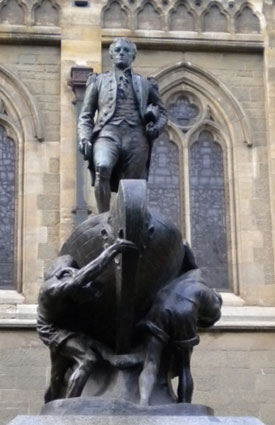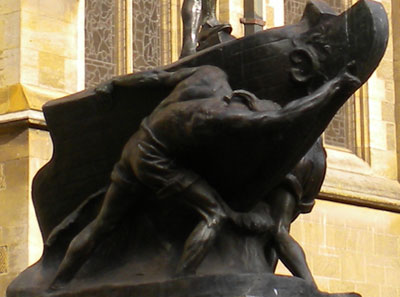 Captain Matthew Flinders (after whom Flinders Station is named in Melbourne) has a statue that was erected in his honour along Swanston Street in 1925. The statue intrigues me because I cannot understand the message that the sculptor was trying to convey. See if this image triggers any questions in your mind.
Captain Matthew Flinders (after whom Flinders Station is named in Melbourne) has a statue that was erected in his honour along Swanston Street in 1925. The statue intrigues me because I cannot understand the message that the sculptor was trying to convey. See if this image triggers any questions in your mind.
 Born in England in 1774, Flinders joined the navy when he was fifteen years old. At seventeen, he sailed with Captain Bligh.
Born in England in 1774, Flinders joined the navy when he was fifteen years old. At seventeen, he sailed with Captain Bligh.
By about his 25th birthday, Flinders sailed to Australia. With him was George Bass. Together, they sailed around Tasmania, just to make sure that it was an island. Flinders named that passage ‘Bass Strait’. Another island was named Flinders Island. In fact, Flinders went about naming lots of places which today roll off our tongue, with no reverence to the steep history.
Starting at the age of twenty-seven, from his ship ‘Investigator’, Flinders went about fulfilling his brief to survey Australia’s coastline. Thanks to him, we have place-names such as Kangaroo Island, and Port Lincoln which was named after his home-town of Lincolnshire. Flinders had many men under his command. He had a good reputation, despite several of his comrades dying for one reason or another.
He passed away aged forty, poor fellow. With such a rich life, and many adventures and achievements, why did the sculptor depict Flinders on a ship, in full uniform, while his servant sailors toil below?
 What baffles me about this sculpture is why he stands aloof, with management report in hand, while one man PUSHES and one man PULLS. Is he neglecting his subordinates? Can he assume that they have misunderstood his instructions? How frustrating it must be for these poor sailors who are trying their best, to no avail. If tugging in opposing directions, we can assume that the ship would not be moving. So much for the notion of ‘all pushing in the same direction’. Imagine the dozens of clichés that this sculpture conjures about management and leadership, including, ‘The left hand not knowing what the right hand is doing’, or ‘All shoulders to the wheel’, or ‘Leading from the front’.
What baffles me about this sculpture is why he stands aloof, with management report in hand, while one man PUSHES and one man PULLS. Is he neglecting his subordinates? Can he assume that they have misunderstood his instructions? How frustrating it must be for these poor sailors who are trying their best, to no avail. If tugging in opposing directions, we can assume that the ship would not be moving. So much for the notion of ‘all pushing in the same direction’. Imagine the dozens of clichés that this sculpture conjures about management and leadership, including, ‘The left hand not knowing what the right hand is doing’, or ‘All shoulders to the wheel’, or ‘Leading from the front’.
Could it be that this manoeuvre is well known in nautical circles? If so, would someone enlighten us, please. It just struck me that this statue symbolises management in this day and age. Not to cast doubt about Captain Flinders’ capabilities, I see this statue as an interesting observation about the captains of modern industry who think that they can steer their ship towards profit and prosperity, while staff and customers are battling with (and amongst) each other, not knowing which way to go. Older text books referred to the Titanic as a metaphor, warning about hidden icebergs under the surface. In the good old days, management reflected a polished, even glittery, front, while daemons were out of sight and scrutiny, lurking beneath the surface. Yet, this statue is more like the current disease of mismanagement, where nothing is hidden. It is plain and bleeding obvious. Everyone can see the disharmony and they disarray. Notwithstanding, the CEO stands proud, ambivalent and unaware of the trauma underfoot.
These days, management consultants are those whose unpleasant duty it is to point out the jolly obvious to proud people who just cannot see the evident. I can imagine a meeting wherein a CEO in this predicament will stand, chest expanded, in the likeness of dear Matthew Flinders, denying all problems and difficulties. The consultant (I am imagining myself in this picture, having been in these situations all too often) says, ‘Just come down from your high horse for a second and take a look. The problems are obvious, and the solution is simple.’ To which the CEO will respond, ‘From where I’m standing, I think you are imagining things. If you feel strongly about it, write a report.’



Comments are closed.